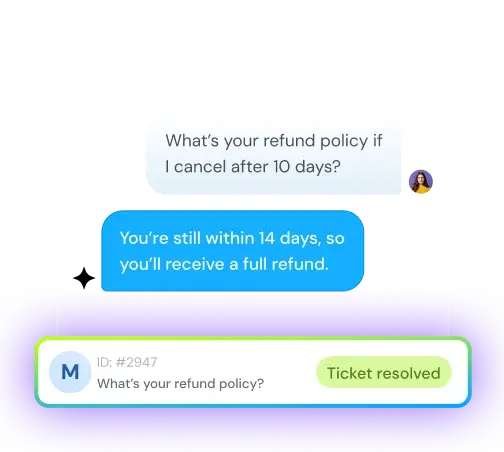How to improve customer service experience: Proven ecommerce strategies for 2025
Sneha Arunachalam
Jun 30, 2025
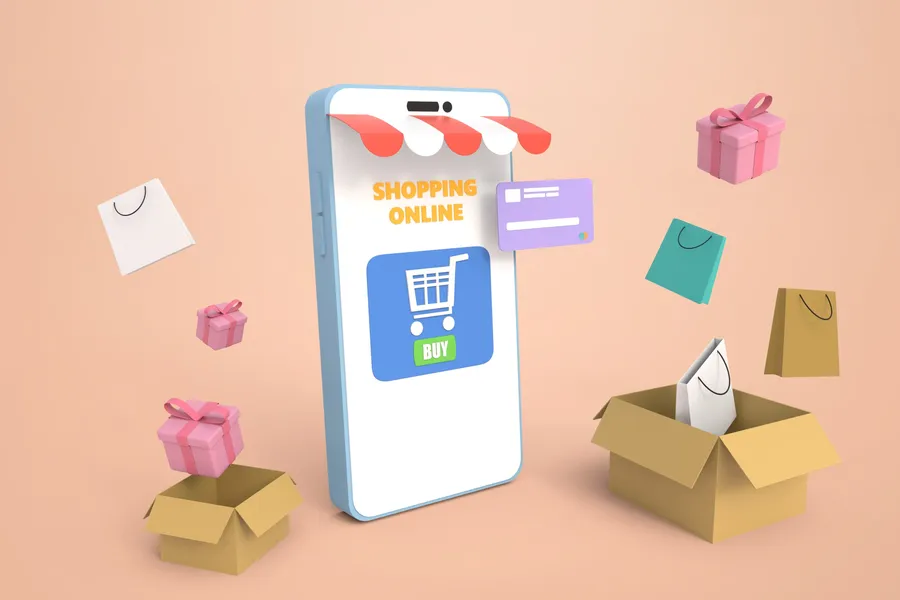
Imagine losing more than two-thirds of your customers—not because of your product, but because of your customer service.
Sounds harsh? It’s reality. A staggering 71% of buyers base their purchase decisions solely on how good their service experience is. If you want to thrive in 2025, knowing how to improve customer service experience isn’t optional—it’s essential.
Here’s the kicker: 80% of shoppers say excellent service matters just as much as the product itself. Yet, despite all the tech advances, 68% of retailers have seen their customer satisfaction scores slide this year. Clearly, something’s broken.
And it’s not just about being fast — though speed is critical. More than half of shoppers switch between three to five channels during a single purchase, and 92% expect their problems solved immediately.
This blog cuts through the noise with clear, practical steps on how to improve customer service experience. We’ll help you meet rising expectations, find the friction points that trip up your customers, and focus on the metrics that truly drive lasting success.
Why ecommerce customer experience is harder than ever
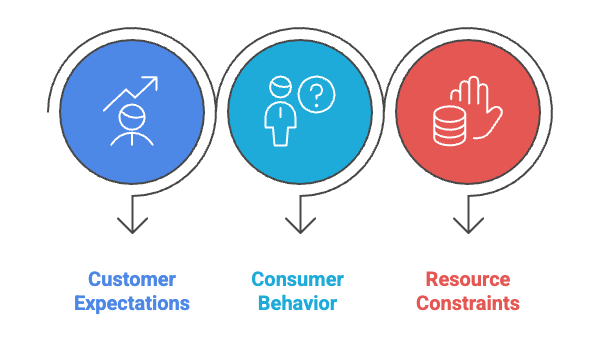
Keeping customers happy online has never been tougher than it is right now. With global e-commerce sales headed toward over $8 trillion by 2026, everyone's fighting for the same shoppers' attention. Here's why giving great service feels like trying to hit a moving target in 2025.
Rising customer expectations
Today's shoppers want everything perfect — and they're not big on waiting. Think about it: nearly 90% expect shopping experiences tailored just for them. And when 77% of people will choose, recommend, or pay extra for personalized service, you can't afford to treat everyone the same.
Delivery expectations? Those have gone through the roof. The big players have trained customers to expect packages practically yesterday. But here's the thing — reliability beats speed every time. Customers would rather wait a full week for a package that arrives when promised than deal with a late delivery that was supposed to be faster.
What else do modern shoppers demand? Quite a list:
- Ways to shop across multiple channels (65% will ditch their cart if your return policy isn't flexible enough)
- Delivery times that fit their schedule (over half of shoppers care about this)
- Earth-friendly shipping options (35% will actually pay more for this)
Unpredictable consumer behavior
Figuring out what customers will do next feels like predicting the weather. As one expert puts it, "the dog that you adopted is likely to stay at your home. But when you go back to ordering your daily Starbucks, are you going to spend the same amount to feed your pet?"
Shoppers are full of contradictions that leave many sellers scratching their heads. They want tons of options but get overwhelmed by choices. They want control but need guidance. They have values they want to live by but can't always follow through. This "decision fatigue" creates a kind of paralysis — faced with too many choices, many customers end up making no choice at all.
On top of that, 83% of online shoppers need assistance just to complete an order. Yet support teams can't predict which channel customers will use, since 64% tried new options like live chat during the pandemic, and 75% plan to keep using them.
Budget and resource constraints
Trying to improve service while keeping costs in check? That's a tough balancing act. Logistics costs have shot up faster than overall inflation for everything from fuel to warehouse space. No wonder 90% of shoppers abandon their carts when shipping costs feel too high.
Business leaders now walk "a tightrope of having to grow the business while being asked to do so with less budget and resources". This juggling act gets even harder when 70% of younger customers consider fast responses essential to good service.
To tackle these challenges, you've got to get creative. One customer experience leader puts it perfectly: "Get scrappy and start testing — fail fast, fail small, learn, then move on". Finding affordable ways to meet sky-high expectations means being smart about where you invest in technology and training.
Mapping the customer journey to improve service
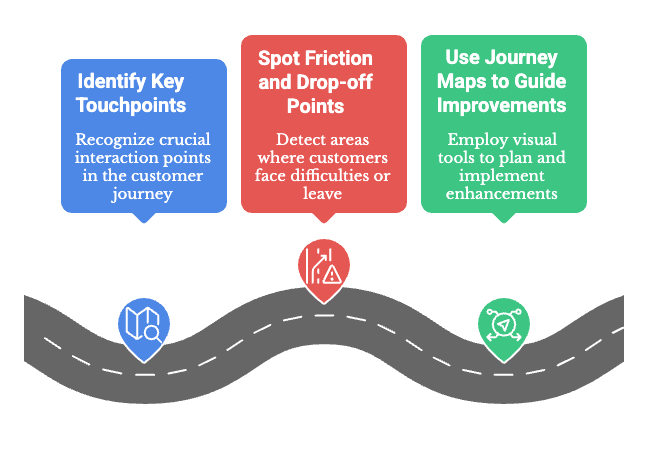
Want to know a secret? You can't fix what you don't understand. Customer journey mapping shows you exactly how shoppers experience your brand — from that first click to the "thanks for your purchase" email and beyond. It's no wonder almost 90% of customer experience professionals who use journey mapping report better metrics like higher satisfaction and fewer customers jumping ship.
Identify key touchpoints
Every time someone interacts with your business, that's a touchpoint. These moments matter more than you might think. Your journey map should track all the ways customers connect with you:
- Website visits, product pages, and checkout
- Email communications and marketing messages
- Social media engagements and customer support
- Post-purchase communications
Start by getting crystal clear about who you're selling to and what they're trying to accomplish at each stage. First-time visitors usually check out your awareness pages after landing on your homepage. Try installing session recording tools to watch exactly how real people navigate your site — these create heat maps that reveal where eyes go and fingers click.
Here's the thing — today's shoppers rarely buy after a single interaction. Research shows they bounce between channels before deciding to purchase, often discovering you on social media, reading your content, then circling back to your site to finally hit "buy".
Spot friction and drop-off points
Ever wonder why over 70% of online shopping carts get abandoned before checkout? That's friction at work — those annoying little hurdles that make customers think "nah, not worth it."
Dig into your data to find where people bail out. Some classic friction points include:
- Slow website loading (53% of mobile users ditch sites that take more than 3 seconds to load)
- Complicated checkout process (each extra step pushes more people away)
- Surprise shipping costs (55% of abandoned carts happen when shipping fees pop up at the last minute)
- Limited payment options (shoppers leave when they can't pay their preferred way)
Use your analytics tools to track how customers move through your funnel and pinpoint exactly where they drop off. Heat maps reveal where people click and scroll, while A/B testing lets you experiment with different elements like forms and menus to see what works better.
Use journey maps to guide improvements
Once you've mapped out the customer journey, use what you've learned to make smart changes. About 71% of companies say journey mapping has convinced management to invest more in customer experience.
These maps show the gap between what you think you're delivering and what customers actually experience. When you visualize the entire journey, you suddenly see where your internal processes create delays or confusion.
Now for the fun part — using these insights to make things better. Consider adding:
- Self-service features like order tracking and returns
- Wish list functionality
- Personalized product recommendations
- Saved shopping carts
- Custom collection pages based on interests
Let me give you a quick example: if you sell outdoor gear, you could use customer data to customize the homepage — hikers see trail gear first, while campers get tents and sleeping bags.
Don't just map once and call it done. Keep tracking real customer journeys to see if your changes are working. Use feedback, analytics, and CRM data to monitor how people interact across touchpoints, spot patterns, and find gaps you missed the first time around.
8 proven strategies to improve ecommerce customer service in 2025
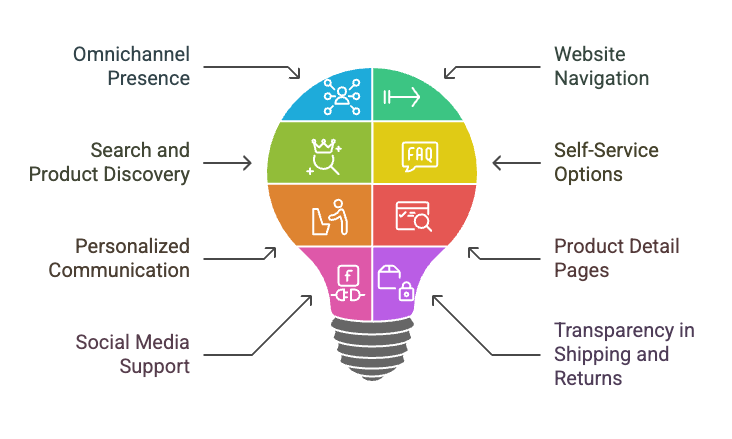
Ready to make your customer service actually work for you? Let's get real about what makes shoppers stick around in 2025. These eight strategies aren't just nice ideas — they're proven ways to create experiences your customers will rave about.
1. Build a strong omnichannel presence
Here's the truth — your customers are all over the place. 73% of online shoppers jump between multiple channels during a single purchase journey. When you connect these touchpoints, you're not just being convenient — you're speaking their language.
Think of it like this: shoppers who use four or more channels spend 9% more than those who stick to just one. That's because they can start browsing on Instagram, check reviews on your website, and finish their purchase through your app without missing a beat.
2. Make your website easy to navigate
Poor navigation is a total customer killer — you can lose up to 55% of visitors just because they can't find their way around. That first impression matters, with 38% of shoppers focusing on your navigation links and layout when they first land on your site.
Keep your menu simple with categories that actually make sense. Most people prefer scrolling these days, so scrollable menus beat click-through options every time. And please, make your logo clickable to get back home — small detail, huge difference.
3. Improve search and product discovery
When someone uses your search bar, they're ready to buy. About 69% of customers hit that search function with their credit cards practically in hand. So why not make it work better with auto-complete, spell check, and decent filtering?
Product discovery goes way beyond basic search though. Give shoppers ways to narrow down what they're looking at based on price, ratings, or features. Visual search is especially huge with younger crowds — 30% of shoppers under 34 use it regularly.
4. Add self-service options like FAQs and chatbots
Most customers would rather help themselves than talk to you — that's just how it is. About 61% prefer finding their own answers for simple stuff. A strong knowledge base, clear FAQs, and smart chatbots often built directly into ecommerce live chat make self-service fast and frustration-free.
The best part? AI chatbots can handle up to 70% of questions automatically. They work 24/7, answering those same shipping and return questions for the thousandth time without getting cranky. Your message volume could drop by 80% — imagine what your team could do with that time back.
5. Personalize post-purchase communication
That moment after purchase? Totally emotional — 53% of shoppers say it's when they feel most connected to your brand. So why send generic "Your order has shipped" emails when personalized ones get 81% higher click rates?
Keep them updated about their order status, but make it feel human. Follow up with a review request when they're still excited about their purchase. Toss in a little extra like a sticker or handwritten note and watch how quickly they become your biggest fans.
6. Optimize product detail pages
Product pages can make or break your sale. Show multiple high-quality images from different angles with zoom that actually works. Your descriptions should balance "here's what it is" with "here's why you'll love it."
Social proof isn't optional anymore — real customer reviews build the trust needed to hit "buy now." And don't forget to suggest related products based on what they're looking at. It's not just about boosting sales (though it does) — it creates a better overall experience.
7. Use social media for real-time support
Over a billion people message businesses on Facebook every week. That's not something you can ignore. When you respond quickly to questions and complaints on social, 64% of customers will spend more with you when you solve problems right there on the platform they're using.
Speed matters here — 77% of customers expect an immediate response. Tools like Hootsuite Inbox let you manage comments and messages across platforms in one place, making your team faster and more consistent.
8. Be transparent with shipping and returns
Nobody likes surprises when it comes to shipping and returns. Make your policies crystal clear — 63% of customers expect at least a 30-day return window. Give them tracking info so they can watch their order make its way to their door.
Almost 94% of shoppers expect you to tell them about delivery times before they have to ask. Offering flexible delivery options that match what customers actually want leads to happier shoppers who come back again and again.
Bonus tips: Add thoughtful friction to improve satisfaction
Let’s be real — making everything super easy isn’t always the best move. Most online stores aim to clear every obstacle from the buying process, but sometimes, a little bit of thoughtful friction — those small, intentional pauses that make customers stop and think — can actually lead to a better experience and higher satisfaction.
Encourage better decision-making
Have you ever noticed how a chocolate tastes richer when you unwrap it yourself? That’s friction working in your favor. These tiny moments give shoppers a chance to slow down and really consider what they’re about to buy. In your online store, this could mean:
- Showing the full cost upfront, including shipping and taxes, early in checkout
- Highlighting honest, real customer reviews right on the product pages
- Writing clear product descriptions that set realistic expectations
These little speed bumps help prevent impulse buys and encourage customers to pick what truly fits their needs. When shoppers focus on choosing the right product instead of just hunting for the cheapest option, they end up feeling way better about their purchase. This is a smart way to improve customer satisfaction and is key when learning how to improve customer service experience overall.
Reduce buyer’s remorse
The return numbers are staggering — nearly 16% of all online purchases get sent back, totaling around $200 billion in returned goods every year. Thoughtful friction is a great way to cut down on this.
Giving customers a moment to pause before they hit "buy now" helps curb the habit of "bracketing," where people order multiple sizes or variations planning to return most of them. That pause creates space for real reflection on whether they actually need everything in their cart.
Clear, detailed product info helps too — good photos from multiple angles, honest descriptions, and plenty of genuine reviews all set the right expectations. When people put more thought into their purchases, they feel more connected to what they’ve chosen. This is an important part of how to improve customer service experience because it leads to fewer returns and happier customers.
Create deeper brand engagement
Think of it like this: the famous “Ikea effect” shows that people value things more when they’ve invested effort into getting them. Adding thoughtful friction to your shopping experience builds stronger ties between customers and your brand.
Take Betty Crocker as an example — their cake mixes used to only need water, but customers didn’t feel much pride or connection. When the recipe was changed to require adding eggs and oil, people felt more accomplished and more invested in the final cake.
For your store, this might mean offering product customization or adding helpful, educational content about what you sell. These small friction points boost customer investment in their buying journey, making their experience more memorable and encouraging stronger loyalty. That’s another smart approach when figuring out how to improve customer service experience in meaningful ways.
Track the right metrics to measure success
Let’s talk numbers — because you can’t improve what you don’t measure. The right metrics give you a clear picture of where your customer service is thriving and where it could use work. Here are four key ones that really matter in 2025:
Net promoter score (NPS)
NPS asks one simple question: "How likely are you to recommend us to a friend or colleague?"
- Promoters (9-10): These customers love you and spread the word
- Passives (7-8): They’re satisfied but won’t actively promote you
- Detractors (0-6): Unhappy customers who could hurt your reputation
Your score is promoters minus detractors, ranging from -100 to +100. Anything above 50 is good, and 70+ means you’re killing it. Companies with high NPS grow twice as fast as their competitors — a must-watch number to improve customer satisfaction.
Customer satisfaction score (CSAT)
CSAT measures how happy customers are right after an interaction by asking a simple question like: "How was your experience today?"
You calculate it by dividing positive responses by total responses, then multiplying by 100. Scores between 75-85% are solid. Unlike NPS, CSAT gives you a snapshot of the current moment — perfect for quickly spotting issues and improvements.
Customer effort score (CES)
CES asks: How easy was it for customers to get what they needed? This is huge because 94% of customers who have a low-effort experience buy again, compared to just 4% who felt they had to jump through hoops. Easy experiences also cost 37% less to deliver — a win for both customers and your business.
Customer lifetime value (CLV)
CLV estimates the total revenue a customer will bring over their relationship with your brand. The formula is simple: Average Purchase Value × Purchase Frequency × Average Customer Lifespan.
For example, if your clothing store averages $50 per sale, with customers buying three times a year for two years, their CLV is $300. Knowing this helps you decide how much to spend acquiring customers while staying profitable.
Conclusion
Exceptional customer service isn’t just a nice bonus anymore; it’s what sets winners apart in 2025. Throughout this blog, we’ve seen that shoppers want more, expect more, and frankly, deserve more from the brands they choose to spend with.
Think of your customer journey like a roadmap — it reveals where people get stuck and where they glide through effortlessly. Those touchpoints? They’re your golden chances. Nail those strategies — from seamless cross-channel experiences to crystal-clear shipping info — and you’re not just meeting expectations, you’re smashing them.
Here’s a surprise: not all friction hurts your business. The right kind — those thoughtful pauses that get customers to think twice — can actually deepen their connection to your brand. It sounds counterintuitive, but it really works.
The metrics we talked about? They’re more than just dashboard numbers. NPS, CSAT, CES, and CLV are like your business’s vital signs, showing what’s healthy and what needs fixing.
The online shopping world will keep evolving (that’s guaranteed), but one thing won’t change: customers remember how you make them feel. Brands that get this right now will be the ones standing tall in 2025 and beyond.
Start small if you have to. Even tiny improvements can make a huge difference in customer satisfaction. After all, great customer service isn’t about avoiding problems — it’s about creating experiences customers can’t wait to share with their friends.
If you’re serious about how to improve customer service experience, these thoughtful strategies and metrics are your best bet for lasting success.
Quick summary: How to improve customer service experience in ecommerce
In 2025, knowing how to improve customer service experience isn't optional—it's essential for business survival. With 71% of buyers basing purchase decisions solely on service quality and 80% of shoppers valuing excellent service as much as the product itself, customer experience has become the ultimate differentiator in ecommerce.
- Build omnichannel presence across multiple touchpoints (73% of shoppers use multiple channels)
- Optimize website navigation to prevent losing 55% of visitors due to poor navigation
- Enhance search and product discovery with auto-complete and filtering options
- Implement self-service options like FAQs and AI chatbots to handle 70% of inquiries
- Personalize post-purchase communication for 81% higher click rates
- Add thoughtful friction through detailed product info to reduce returns and buyer's remorse
- Use social media for real-time support
- Maintain transparency in shipping and return policies
- Track essential metrics: NPS, CSAT, CES, and CLV for measurable success
Exceptional customer service separates winners from losers in today's competitive landscape. Understanding how to improve customer service experience through strategic touchpoint optimization and meaningful engagement creates lasting customer relationships. While the digital world evolves rapidly, one constant remains: customers remember how brands make them feel. Companies implementing these strategies now will dominate in 2025 and beyond.
Frequently Asked Questions
Clear product descriptions, accurate photos, and real reviews go a long way. Giving shoppers time to reflect before buying — even a subtle “Are you sure?” moment — helps cut down on returns from rushed or uncertain purchases.
Many ecommerce brands focus too much on speed or shiny tools and overlook the actual customer journey. They forget the emotional side of service — how customers feel during and after a purchase. Another common blind spot? Ignoring post-purchase touchpoints and treating support like a cost instead of a growth driver.
Make your self-service feel human by writing in a warm, conversational tone and anticipating real customer questions. Use clear visuals, step-by-step guides, and searchable FAQs to simplify complex topics. Most importantly, update content regularly based on actual support tickets and feedback.
Focus on feedback that reveals friction points in the buying or support journey — like confusion, delays, or unmet expectations. Prioritize repeated issues over one-off complaints, and always dig into “why” behind negative reviews. The most valuable insights usually come from open-ended comments, not just star ratings.
Thoughtful friction can encourage better decision-making, reduce buyer's remorse, and create deeper brand engagement. By adding strategic pauses in the buying process, customers make more informed decisions, feel more connected to their purchases, and ultimately experience higher satisfaction.
